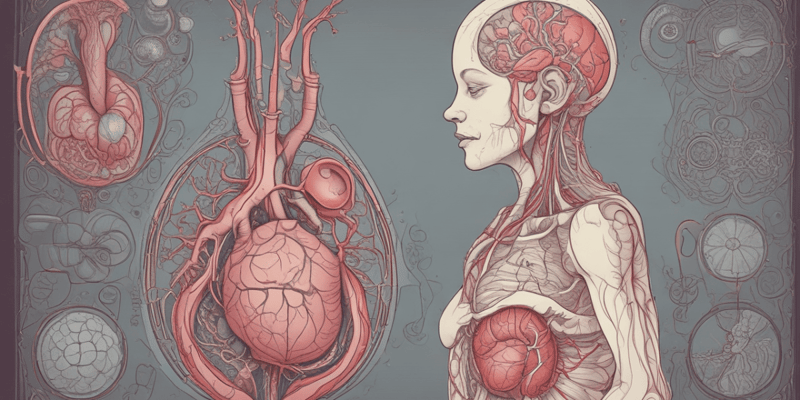Podcast
Questions and Answers
At what week of gestation does fetal circulation develop?
At what week of gestation does fetal circulation develop?
What is the function of the ductus venosus?
What is the function of the ductus venosus?
What is the pathway of blood flow from the placenta to the heart in fetal circulation?
What is the pathway of blood flow from the placenta to the heart in fetal circulation?
What is the function of the foramen ovale?
What is the function of the foramen ovale?
Signup and view all the answers
What becomes the ligamentum venosum in adults?
What becomes the ligamentum venosum in adults?
Signup and view all the answers
What is the function of the ductus arteriosus?
What is the function of the ductus arteriosus?
Signup and view all the answers
What becomes the medial umbilical ligament in adults?
What becomes the medial umbilical ligament in adults?
Signup and view all the answers
What is the pathway of blood flow from the heart to the placenta in fetal circulation?
What is the pathway of blood flow from the heart to the placenta in fetal circulation?
Signup and view all the answers
What is the function of the umbilical vein?
What is the function of the umbilical vein?
Signup and view all the answers
What is the fate of the ductus arteriosus in adults?
What is the fate of the ductus arteriosus in adults?
Signup and view all the answers
Study Notes
Fetal Circulation
- Develops around the 12th week of gestation
- Mainly consists of structures that deliver blood from the fetus to the placenta or from the placenta back to the fetus
Umbilical Cord and Placenta
- Umbilical cord has two vessels: one is the umbilical vein (red) which takes oxygenated blood from the placenta to the heart
- Umbilical vein shunts blood into the inferior vena cava through the ductus venosus
- Ductus venosus is a tiny shunt that shunts blood from the umbilical vein into the inferior vena cava
- In adults, ductus venosus becomes the ligamentum venosum
Fetal Heart Structures
- Blood from the inferior vena cava dumps into the right atrium
- Foramen ovale (orange pipe cleaner) is a hole between the right atrium and left atrium
- In adults, foramen ovale becomes the fossa ovalis (a scar tissue)
Bypassing the Pulmonary Circuit
- Ductus arteriosus is a shunt between the pulmonary trunk and the aorta
- Prevents blood from going to the lungs
- In adults, ductus arteriosus becomes the ligamentum arteriosum
Umbilical Artery
- Deoxygenated blood flows from the fetus to the placenta
- Umbilical artery becomes the medial umbilical ligament in adults
Blood Flow in Fetal Circulation
- Blood flows from the placenta through the umbilical vein, ductus venosus, and inferior vena cava
- Blood then flows into the right atrium, through the foramen ovale, and into the left atrium
- From the left atrium, blood flows into the left ventricle, aorta, and bypasses the lungs through the ductus arteriosus
- Blood then flows down the aorta, common iliacs, internal iliacs, and umbilical artery, and back to the placenta
Fetal Circulation
- Develops around the 12th week of gestation
- Primary function is to deliver oxygenated blood from the placenta to the fetus and deoxygenated blood from the fetus to the placenta
Umbilical Cord and Placenta
- Umbilical cord has two vessels: umbilical vein (oxygenated blood) and two umbilical arteries (deoxygenated blood)
- Umbilical vein carries oxygenated blood from the placenta to the fetus
- Umbilical vein shunts blood into the inferior vena cava through the ductus venosus
- Ductus venosus is a tiny shunt that diverts blood from the umbilical vein into the inferior vena cava
Fetal Heart Structures
- Blood from the inferior vena cava flows into the right atrium
- Foramen ovale is a hole between the right atrium and left atrium, allowing blood to bypass the pulmonary circuit
- Foramen ovale closes at birth, becoming the fossa ovalis in adults
Bypassing the Pulmonary Circuit
- Ductus arteriosus is a shunt between the pulmonary trunk and the aorta, preventing blood from entering the lungs
- Ductus arteriosus closes at birth, becoming the ligamentum arteriosum in adults
- Allows the fetus to bypass the pulmonary circuit, as oxygenation occurs in the placenta
Umbilical Artery
- Deoxygenated blood flows from the fetus to the placenta through the umbilical artery
- Umbilical artery becomes the medial umbilical ligament in adults
Blood Flow in Fetal Circulation
- Oxygenated blood flows from the placenta through the umbilical vein, ductus venosus, and inferior vena cava
- Blood then flows into the right atrium, through the foramen ovale, and into the left atrium
- From the left atrium, blood flows into the left ventricle, aorta, and bypasses the lungs through the ductus arteriosus
- Blood then flows down the aorta, common iliacs, internal iliacs, and umbilical artery, and back to the placenta
Fetal Circulation
- Develops around the 12th week of gestation
- Primary function is to deliver oxygenated blood from the placenta to the fetus and deoxygenated blood from the fetus to the placenta
Umbilical Cord and Placenta
- Umbilical cord has two vessels: umbilical vein (oxygenated blood) and two umbilical arteries (deoxygenated blood)
- Umbilical vein carries oxygenated blood from the placenta to the fetus
- Umbilical vein shunts blood into the inferior vena cava through the ductus venosus
- Ductus venosus is a tiny shunt that diverts blood from the umbilical vein into the inferior vena cava
Fetal Heart Structures
- Blood from the inferior vena cava flows into the right atrium
- Foramen ovale is a hole between the right atrium and left atrium, allowing blood to bypass the pulmonary circuit
- Foramen ovale closes at birth, becoming the fossa ovalis in adults
Bypassing the Pulmonary Circuit
- Ductus arteriosus is a shunt between the pulmonary trunk and the aorta, preventing blood from entering the lungs
- Ductus arteriosus closes at birth, becoming the ligamentum arteriosum in adults
- Allows the fetus to bypass the pulmonary circuit, as oxygenation occurs in the placenta
Umbilical Artery
- Deoxygenated blood flows from the fetus to the placenta through the umbilical artery
- Umbilical artery becomes the medial umbilical ligament in adults
Blood Flow in Fetal Circulation
- Oxygenated blood flows from the placenta through the umbilical vein, ductus venosus, and inferior vena cava
- Blood then flows into the right atrium, through the foramen ovale, and into the left atrium
- From the left atrium, blood flows into the left ventricle, aorta, and bypasses the lungs through the ductus arteriosus
- Blood then flows down the aorta, common iliacs, internal iliacs, and umbilical artery, and back to the placenta
Studying That Suits You
Use AI to generate personalized quizzes and flashcards to suit your learning preferences.
Description
Learn about the development of fetal circulation and the roles of the umbilical cord and placenta in delivering oxygenated blood to the fetus. Understand the structures involved and how they function.




